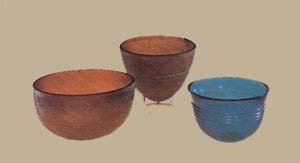Image Details

Courtesy Israel Museum/Photo by Nachum Slapak
A revolution in the glass industry occurred during the Hellenistic period. Its cause is unknown, but its sign is a great increase in the quantity of glass artifacts. An explosion of glass casting in the second and first centuries B.C.E. sometimes left behind at a single site the remains of thousands of cast glass bowls, such as these rare, intact examples of unknown provenance. In his excavations in Jerusalem’s Jewish Quarter, for example, Nahman Avigad found the refuse of a glass factory, including hundreds of fragments of cast glass bowls (see photograph), raw material that had been stored for reuse. Glass casting in the Hellenistic period used the same technique as metal casting, in which the molten material was molded into the desired shape by the lost-wax process.
